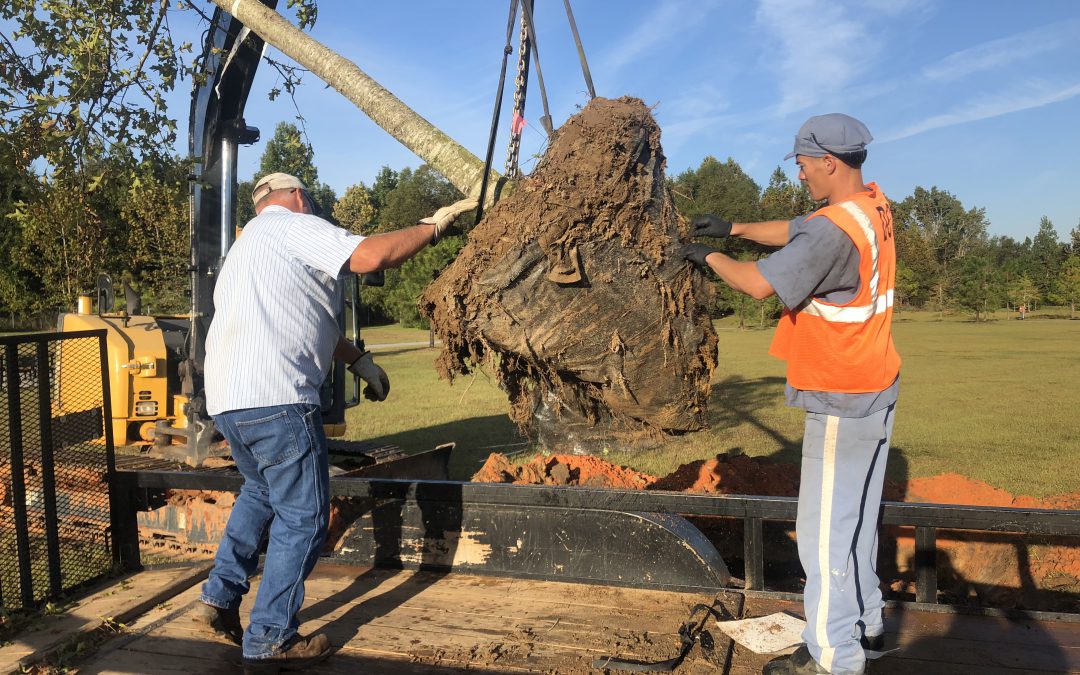
by Matt Lollar | Dec 9, 2020
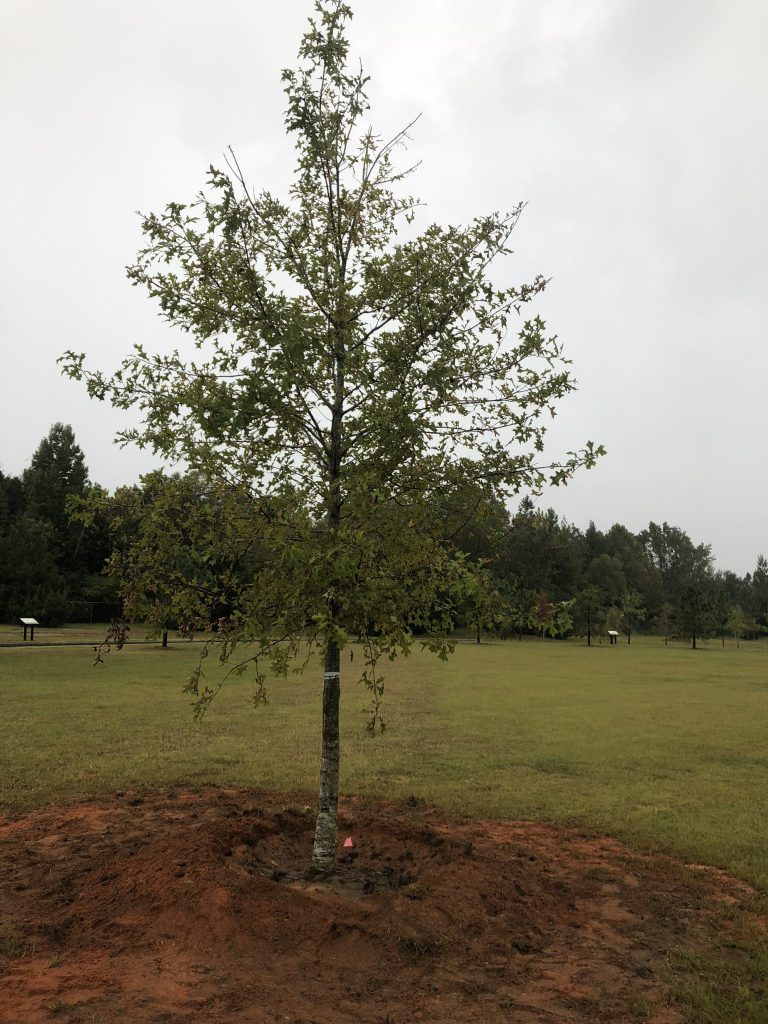
A planted tree with water retention berm. Photo Credit: Matt Lollar, University of Florida/IFAS Extension – Santa Rosa County
Often, Extension agents are tasked with evaluation of unhealthy plants in the landscape. They diagnose all sorts of plant problems including those caused by disease infection, insect infiltration, or improper culture.
When evaluating trees, one problem that often comes to the surface is improper tree installation. Although poorly installed trees may survive for 10 or 15 years after planting, they rarely thrive and often experience a slow death.
Fall/winter is an excellent time to plant a tree in Florida. Here are 11 easy steps to follow for proper tree installation:
- Look around and up for wire, light poles, and buildings that may interfere with growth;
- Dig a shallow planting hole as wide as possible;
- Find the point where the top-most root emerges from the trunk;
- Slide the tree carefully into the planting hole;
- Position the point where the top-most root emerges from the trunk slightly above the landscape soil surface;
- Straighten the tree in the hole;
- Remove synthetic materials from around trunk and root ball;
- Slice a shovel down in to the back fill;
- Cover the exposed sides of the root ball with mulch and create water retention berm;
- Stake the tree if necessary;
- Come back to remove hardware.
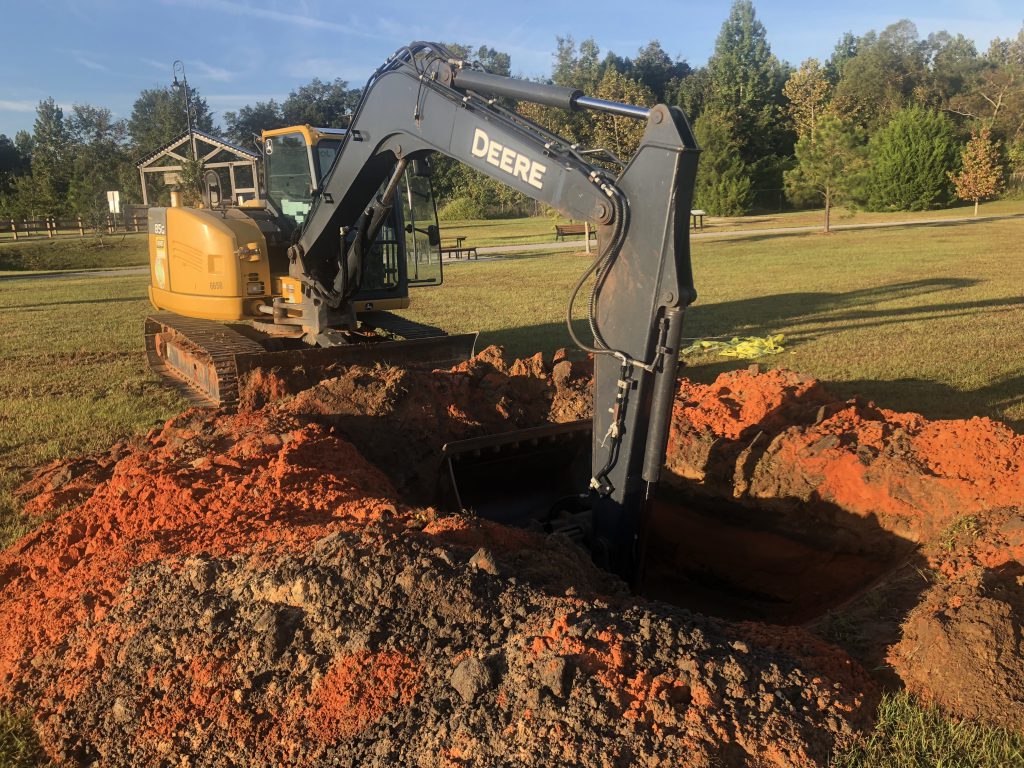
Digging a properly sized hole for planting a tree. Photo Credit: Matt Lollar, University of Florida/IFAS Extension – Santa Rosa County
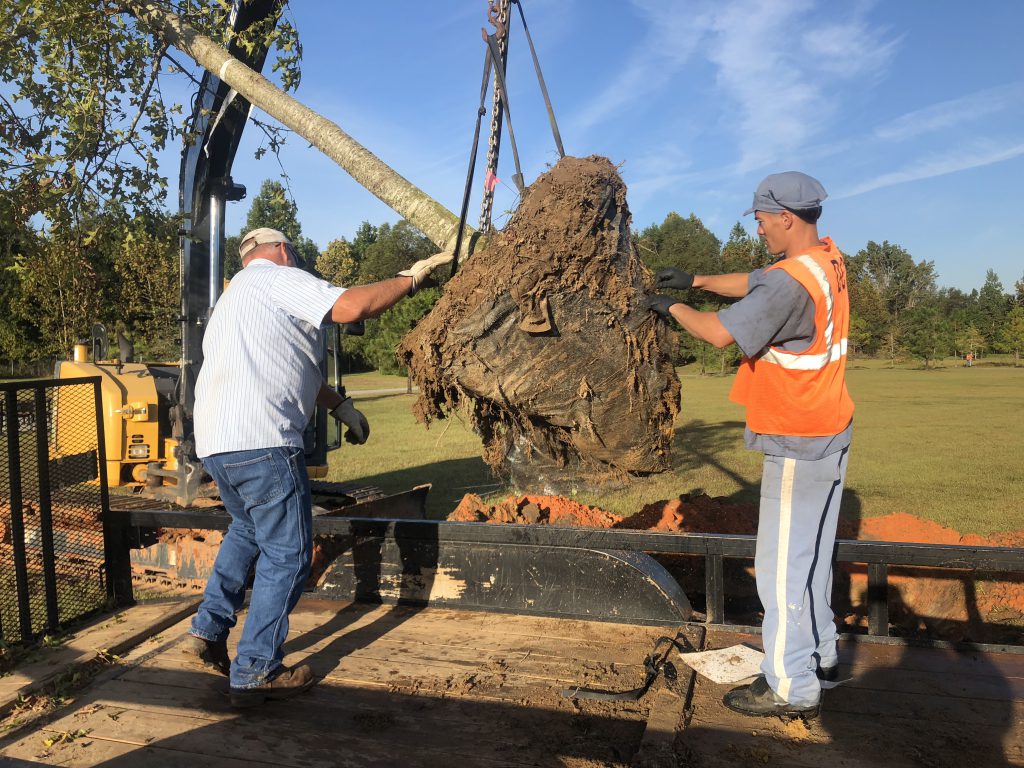
Removing synthetic material from the root ball. Photo Credit: Matt Lollar, University of Florida/IFAS Extension – Santa Rosa County
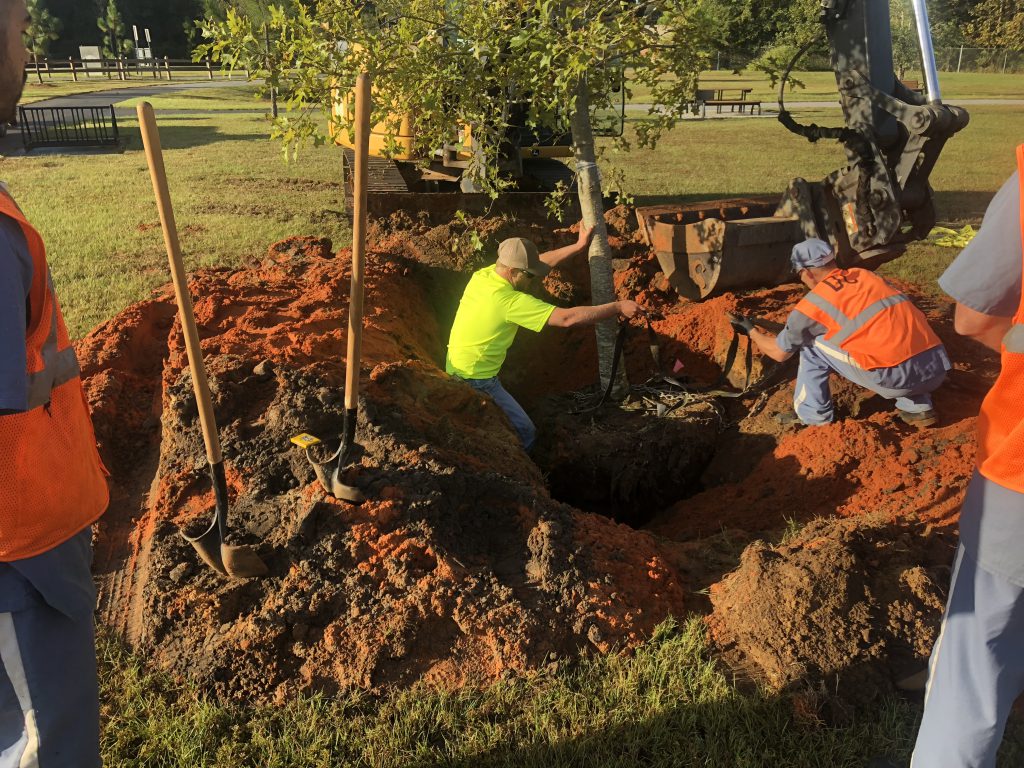
Straightening a tree and adjusting planting height. Photo Credit: Matt Lollar, University of Florida – Santa Rosa County
For more detailed information on planting trees and shrubs visit this UF/IFAS Website – “Steps to Planting a Tree”.
For more information Nuttall Oaks visit this University of Arkansas Website.
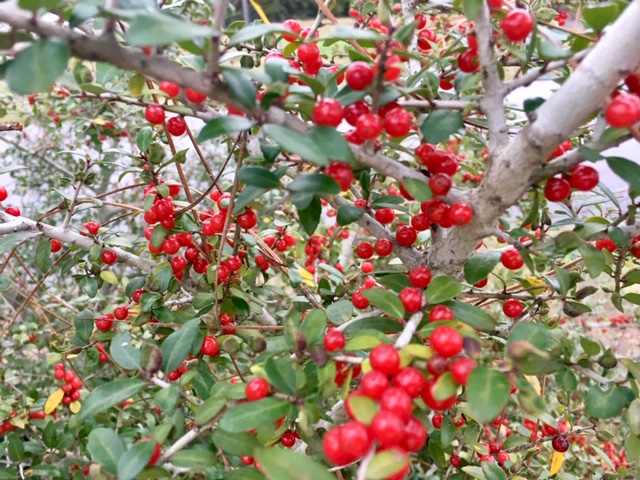
by Larry Williams | Dec 4, 2020

Native yaupon holly with bright red winter berries. Photo credit: Larry Williams
Holly plants are sometimes associated with Christmas. Their dark evergreen leaves and bright red berries fit right in with the Christmas Season. Some people intentionally plant hollies for the purpose of eventually using this desirable combination of green and red to create a more festive Holiday Season. But what if your hollies never produce berries?
The reason may be because you have a male plant. Male holly plants never produce berries. Holly plants are either male or female. The botanical term for this is dioecious. If a male plant is selected, it will produce male flowers and pollen but never set fruit.
One way to know that you’ve selected a female holly is by purchasing a plant with berries. However, you still will need a male plant nearby or no berries will be produced. Generally one male plant is adequate to insure pollination and good fruit set of berries on all female plants in a landscape. Your next-door neighbor may have a male holly plant that would serve as a pollinator for your hollies. Pollen produced by male flowers is transported by bees from distances up 2 miles. And because we are blessed with a number of native hollies in North Florida, chances are good that there will be a male holly within the appropriate distance in the wild to take care of the pollination.
The holly genus (Ilex) offers a terrific variety of plants from which to choose. Some horticulturists estimate that there are about 700 species worldwide. And there are a great number of cultivated varieties! When selecting a holly for your landscape, it is important to know that most dwarf holly cultivars don’t produce fruit as they are propagated by cuttings from male plants. Not all hollies have spiny leaves. For example, many of the Japanese hollies (Ilex crenata) have spineless leaves. There are hollies that grow tall, eventually making a tree. There are dwarf hollies that grow to only three to five feet in height. There are hollies with variegated leaves. And even though most hollies are evergreen, there are a few deciduous hollies that make nice additions to North Florida landscapes such as Ilex ambigua (Ambiguous Winterberry) and Ilex decidua (Possumhaw holly). Some hollies produce bright red berries but berry color varies from red, orange, yellow and even black or white, depending on variety. There are weeping forms available such as the weeping yaupon holly. There are those that have a very narrow, upright growth habit.
For more info on this diverse and interesting group of plants, visit the below UF/IFAS Extension webpage.
http://gardeningsolutions.ifas.ufl.edu/plants/trees-and-shrubs/shrubs/holly.html

by Daniel J. Leonard | Oct 28, 2020
In the Panhandle, fall is the prettiest season for wildflowers. Our roadsides and woodlands are covered with pinks, whites, yellows, blues, purples, and even a little red here and there. Pretty as it may be, the beautiful wildflower look isn’t super appropriate for most yards. It would look unkempt, a little “wild” if you will, would be hard to manage and is probably best enjoyed in natural areas. However, we can bring some of the native colors of fall into our landscapes in a much lower maintenance, refined manner with two Panhandle species that pair excellently together, Muhly Grass (Muhlenbergia capillaris) and Darrow’s Blueberry (Vaccineum darrowii).
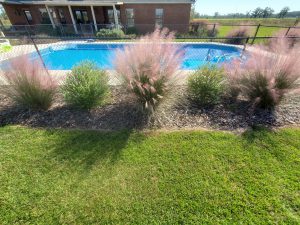
Muhly Grass and Darrow’s Blueberry in a local landscape. Photo courtesy of Daniel Leonard.
Muhly Grass, the native grass with the pinkish/purple panicles blooming right now, has gained much popularity in recent years, earning a reputation as a near pest/disease free, drought tolerant, attractive landscape plant. Operating in lieu of more traditional low growing shrubs in landscapes, Muhly is an airy, greenish gray bunch grass growing about 3-4’ tall and wide, lending informal, coastal texture to landscapes most of the year and really shining in fall during its flowering season. Once established, it never needs extra water, prefers little fertilizer, and only needs a rejuvenation prune (or burn – the Leonard preferred method. It’s fun and mimics the role of fire in Muhly’s native ecosystems!) every couple of years to keep it looking tidy.
Unlike Muhly Grass, Darrow’s Blueberry has not caught on broadly in the landscape industry but is no less deserving. This native blueberry species only grows a couple of feet tall, produces edible fruit that wildlife enjoy, and adds an unusual blue green color to landscapes via its tiny-leaved, evergreen foliage. It prefers the same sites as Muhly and is part of the reason they pair so well together. Our mostly sandy, well drained soils work just fine, but both plants can handle soils that are occasionally wet. A bonus, Darrow’s also has tiny, bell shaped flowers in spring that attract all manner of beneficial bee species. This makes it a must in any native pollinator garden!
As good as these species are alone, I think they are better together. In my family’s yard, we created a loose screen of widely spaced (8’ apart) Muhly Grass specimens around a pool, in the spirit of giving the area a “coastal” airy feel, and interspersed Darrow’s Blueberry in between.
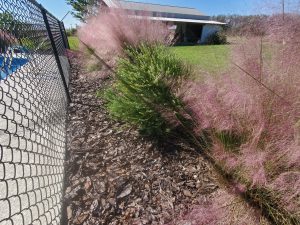
The pink Muhly Grass flowers pair nicely with the green blue foliage of Darrow’s Blueberry. Photo courtesy of Daniel Leonard.
The look has been outstanding, particularly in the late summer/early fall. The pinky purple flowers of Muhly Grass complement the green-blue foliage of the blueberries nicely and provide easy, lasting color without having to worry about planting finicky annuals or perennials each season.
Landscaping with natives does not have to look wild and unkempt, nor does it have to be drab and unattractive. Combining native yet showy plants like Darrow’s Blueberry and Muhly Grass makes for an unusual, refined, nearly no-maintenance feature in your landscape. Look for these and other neat native plants at native nurseries and independent garden centers around the Panhandle. If you’d like more information on native grasses, blueberries or any other horticultural topic, please contact your local UF/IFAS County Extension Office! Happy Gardening!

by Larry Williams | Aug 14, 2020
Oleander caterpillars, which are active on some oleanders during summer, can provide a number of gardening lessons.
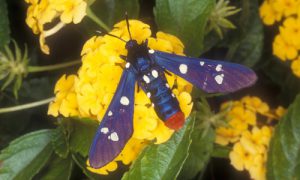
Oleander caterpillar moth on lantana flower. Photo credit: James Castner, UF
The adult moth is striking in appearance. The bluish to purplish moth has white dots on its black wings. The moths resemble wasps as they fly in and around oleander shrubs.
It’s the orange caterpillars with black spots and black hairs that cause problems for some gardeners.
Caterpillars are the larval stage of butterflies and moths. In order to enjoy watching butterflies and moths feeding on the nectar of flowers, some of the caterpillars must survive to become adult butterflies and moths. This is lesson number one.
Oleander caterpillars usually only feed on oleander plants. Oleanders are native to areas of Europe and Asia. This is lesson number two.
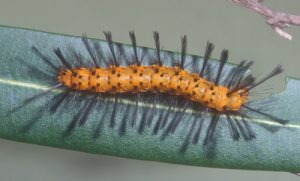
Oleander caterpillar, Photo credit: Paul Choate, UF
Oleander caterpillars benefit by us planting their food source in Florida.
This relationship between pest and plant is referred to as the key plant, key pest concept. Some other examples include St. Augustinegrass and chinch bugs, gardenias and whiteflies, crape myrtles and crape myrtle aphids, azaleas and azalea caterpillars, camellias and tea scale, roses and black spot, pecans and pecan scab, squash and squash vine borers.
Understanding this concept can be helpful in designing a “low maintenance” landscape.
When you plant roses, you plant everything that goes with roses, including the time and money required to maintain them. This applies to St. Augustinegrass, pecan trees, squash and oleanders. This is lesson number three.
Oleander caterpillars can temporarily damage the appearance of oleanders. But they cause no long-term damage for the plant. This is lesson number four. The damage is aesthetic. Oleander caterpillars can consume great numbers of leaves. However, if the plant is otherwise healthy, new leaves will be produced and the plant will continue to grow. The damage is temporary; there will be no evidence the plant ever had a problem.
To spray or not to spray for oleander caterpillars has to do with a person’s tolerance level.
If you can’t tolerate having oleander caterpillars around and the temporary aesthetic damage they cause, consider the use of Bacillus thuringiensis. It is sold under a number of brand names and many times is referred to as Bt. This bacterium only controls caterpillars so it is friendlier for the beneficial insects. When using any pesticide, always follow the label directions and precautions.
Here are links to UF/IFAS Extension publications with more info.

by Carrie Stevenson | Aug 14, 2020
Austin N. Fife, PhD student, Entomology
University of Florida IFAS
North Florida Research and Extension Center
Phyllocoptes fructiphilus: a new threat for Florida roses
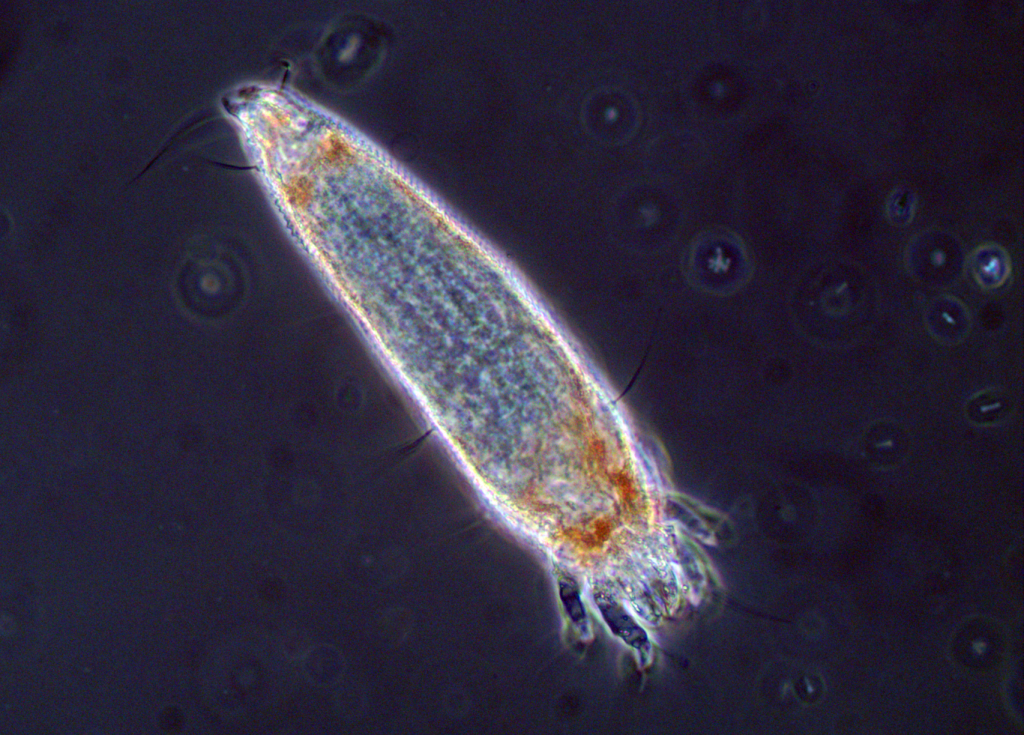
Figure 1: Phyllocoptes fructiphilus . Image Credit Austin N. Fife, UF / IFAS
Phyllocoptes fructiphilus Kefier is a microscopic plant-feeding arachnid belonging to a group of spindle-shaped mites known as Eriophyoid mites. Eriophyoid mites are second only to spider mites in their economic importance and potential for plant damage: some species create galls, others deform plants with their feeding activity, and a few species are capable of spreading viruses. Fortunately, eriophyoid mites very host specific and P. fructiphilus only feeds on plants in the genus Rosa, which includes all of the true roses which we are familiar with.
P. fructiphilus does not cause damage by its feeding alone, but is a pest due to its relationship as the vector of an emaravirus: Rose rosette virus (RRV). RRV infection creates Rose Rosette Disease (RRD), with the following symptoms: witches’ brooms/rosetting, deformed flowers, increased prickle density, elongated shoots, reddened leaves and stems, and increased die-back which ultimately kills the rose host. RRD is the most serious disease of roses, creating millions of dollars of losses for growers. Rose Rosette Disease and the mite have invaded the southeastern United States as the non-native Rosa multiflora (Thunb) has spread invasively towards the eastern coast and by the introduction of infected roses from out of state into Florida.
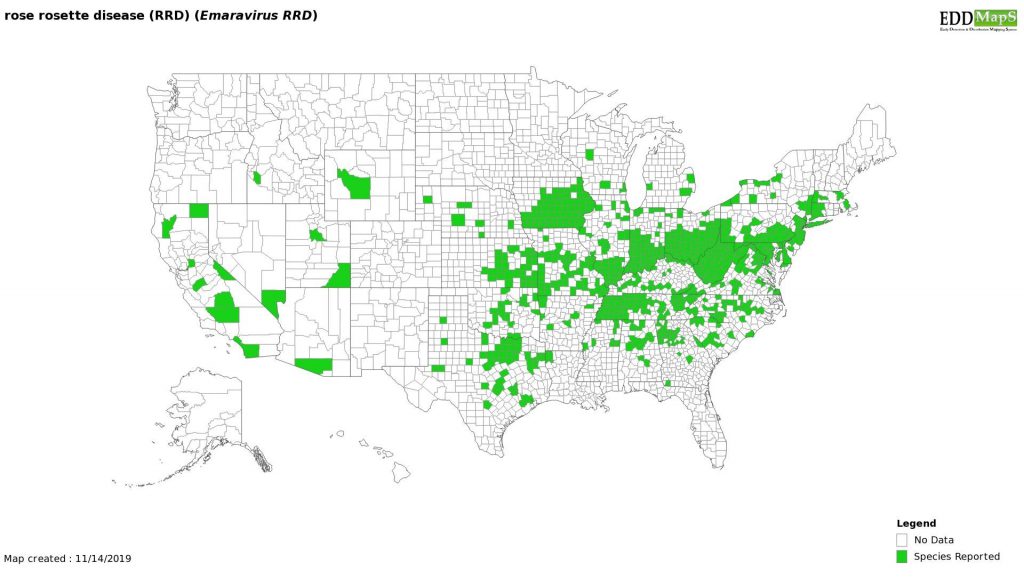
Figure 2: EDDMapS. 2020. Early Detection & Distribution Mapping System. The University of Georgia – Center for Invasive Species and Ecosystem Health. Available online at http://www.eddmaps.org/
RRD was initially detected in Florida in 2014 on 15 plants; however, the plants were destroyed and P. fructiphilus were not detected on the roses after that time.
In early 2019, a survey of predatory mites on roses found eriphyoid mites in samples obtained while surveying roses in Leon County, Florida. The mites were sent to the Florida Department of Agriculture and Consumer Services – Department of Plant Industry (FDACS-DPI) and were all identified as P. fructiphilus by Dr. Sam Bolton. To date, none of these roses have shown signs or symptoms of RDD and none of these plants have tested positive for presence of the virus.
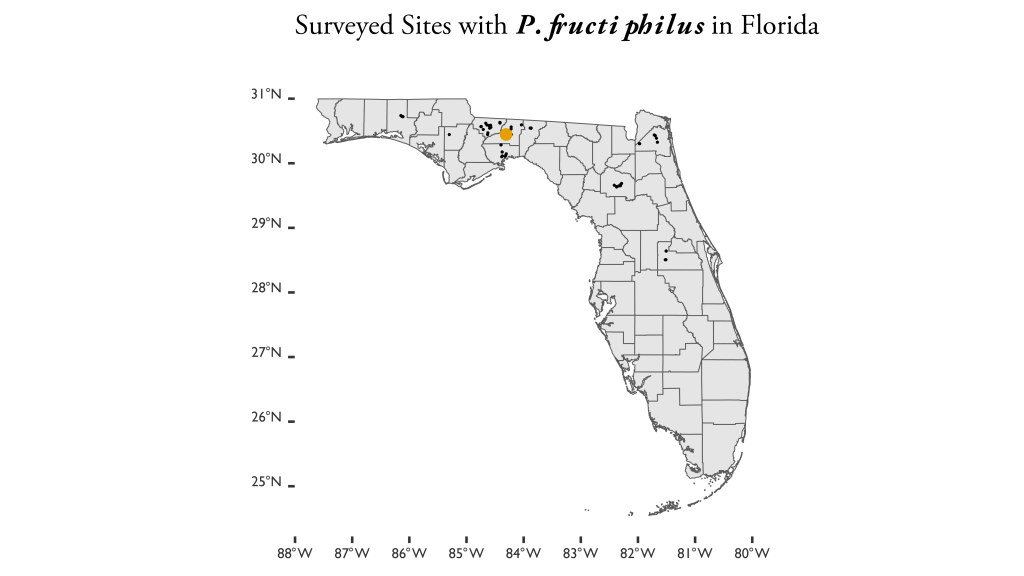
Figure 3: Black dots indicate individual sites which have been surveyed for Phyllocoptes fructiphilus. Orange dots indicate a number of sites with populations of P. fructiphilus detected in Leon county, Florida. No symptoms of Rose Rosette Disease have been seen on these plants to date. Image Credit Austin N. Fife, UF / IFAS
This is the first recorded instance of P. fructiphilus in Florida and is worrisome despite the absence of the virus. Fortunately, RRV is currently not established in Florida. However, the presence of P. fructiphilus, along with past detections of RRV in Florida warrants an increase in monitoring efforts for the mite and virus in Florida.

Figure 4: Typical symptoms of Rose Rosette Disease. Image Credit Austin N. Fife, UF / IFAS
How can I identify roses that have Rose Rosette Disease?
It is difficult to identify the symptoms of RRD in the field for a few reasons. Primarily, there are different growth habits for different rose cultivars. What appears to be ‘excessive thorniness’ in one cultivar may be normal for another, and is can be easy to mistake the redness of new flush with symptoms of the RRD. In addition, glyphosate damage from improper use of Roundup or similar products can have a very similar appearance to diseased roses. The best way to verify RRD infection is to use molecular testing for the virus. Identifying the presences of eriophyoid mites is useful for diagnosis, but they are too small to see with pocket loupes and are difficult to find unless there are large numbers of mites. To properly identify an eriophyoid mite as P. fructiphilus requires the use of a compound microscope with a specially prepared microscope slide of the mite, as well as reference materials and a trained individual who knows what characters to look for.
What to do if I suspect that my roses are infected with Rose Rosette Disease?
We recommend reporting suspected cases of RRD to your local extension agency or the Florida Department of Agriculture.
Where should I send my samples?
Plant Disease Diagnostic Clinic at the North Florida Research and Education Center in Quincy: https://nfrec.ifas.ufl.edu/plant-pathology-clinic/
Mathews Paret, Director, Plant Disease Diagnostic Clinic – UF NFREC (850) 875-7154, paret@ufl.edu
UF/IFAS Disease Diagnostic Center in Gainesville:
- 392-1795, pdc@ifas.ufl.edu
2570 Hull Rd Gainesville, FL 32603
Florida Department of Agriculture and Consumer Services – Division of Plant Industry
1-888-397-1517 Helpline (352) 395-4600 (Helpline Number, Outside of the United States) DPIHelpline@FDACS.gov
The Doyle Conner Building 1911 SW 34th St. Gainesville, FL 32608
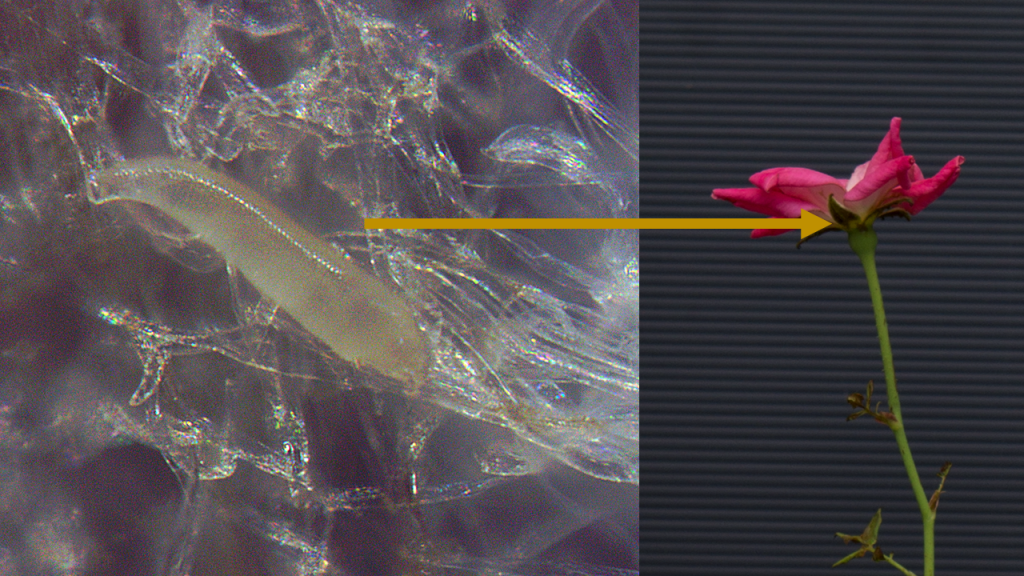
Figure 5: Phyllocoptes fructiphilus is a refuge-seeking mite ,which hides under rose sepals, which are covered in tiny glandular plant hairs known as trichomes that protect the mites. Image Credit: Austin N. Fife, UF / IFAS
How Can I Manage Rose Rosette Disease?
Currently, there are no commercially available rose cultivars known to resist Rose Rosette Disease or Phyllocoptes fructiphilus. A major difficulty lies in the cryptic nature of these mites, which hide underneath the rose sepals. It is important to consider this when considering which control methods to use. Methods which require direct contact with the mites to kill them are unlikely to work.
This makes it difficult for chemical applications which require contact with the pest to work.
Keeping that in mind, there are a few things you can do to reduce your risk of RRD and prevent the spread of the mite:
- Eliminate infected wild roses nearby
- Heavy pruning followed by horticultural oil spray may reduce populations of the mite, but cannot prevent a viral infection from spreading.
- Space plants so their leaves and roots don’t touch
- Dispose of diseased roses properly: bag up infected materials and dispose of in areas away from other roses
- After removing infected plants, spray remaining plants with miticides recommended at https://roserosette.org/control/
- Spray uninfected plants adjacent to removed (infected) plants
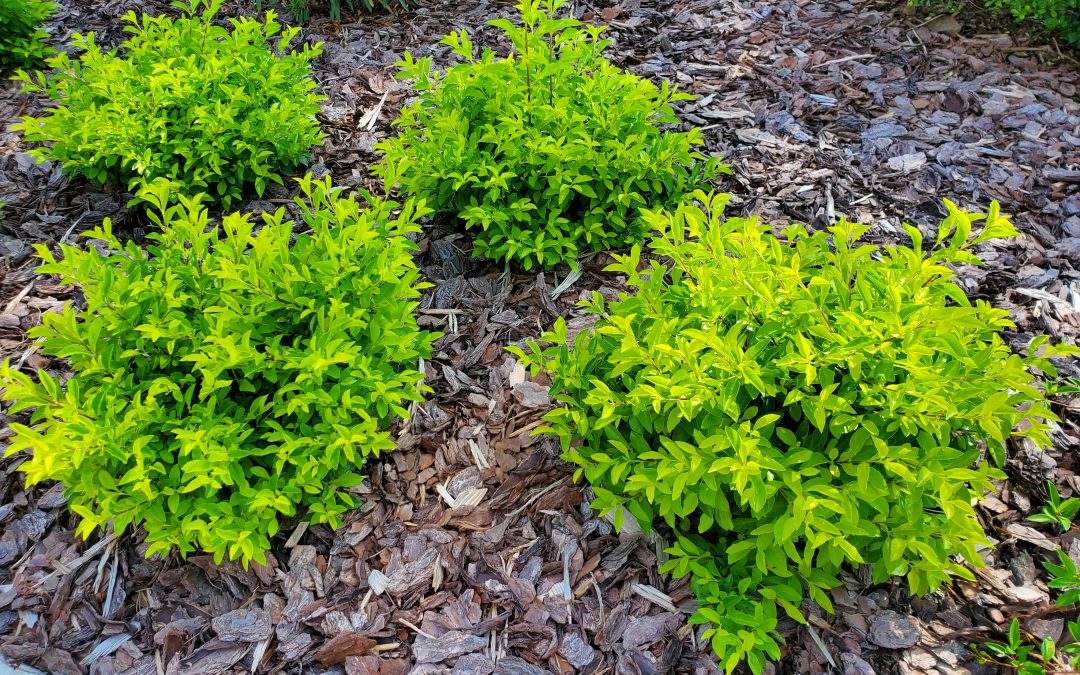
by Daniel J. Leonard | Jul 23, 2020
Flowers can often be fickle in the landscape, so, this year, I decided to add a shot of no-maintenance color to my landscape with foliage plants! The benefits of ornamentals that don’t need flowers to put on a show are many. Their water and fertility needs are often less because they don’t have to support the large energy and irrigation requirements the flowering process demands. They don’t need deadheading to look their best and they lend an awesome texture that is overlooked in many landscapes. My summertime foliage plant of choice provides all those things in a small, bright yellow package; it’s a widely sold selection of Duranta called ‘Gold Mound’.
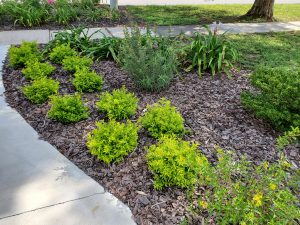
Mass of ‘Gold Mound’ Duranta in the author’s landscape.
‘Gold Mound’ Duranta is a small shrub known for its chartreuse to bright yellow foliage and generally grows 24” or so tall and wide in the Panhandle, allowing it to fit in nearly any landscape. ‘Gold Mound’ has been around in the horticulture trade a long time and is a popular perennial shrub in the southern parts of Florida. It was recognized as the Florida Nursery, Growers, and Landscape Association’s (FNGLA) plant of the year in 2005 and regularly occupies a spot in the color displays of big box and local nurseries, even in the Panhandle, however, despite these attributes, ‘Gold Mound’ is a rare find in Northwest Florida landscapes. That needs to change!
In our neck of the woods, Duranta ‘Gold Mound’ is incredibly low maintenance. I planted a grouping of thirteen specimens near the end of my driveway to provide a consistent season long splash of color to complement the fleeting blooms of the spring flowering shrubs, the drab greenery of the neighbor’s lawn and the on-again, off-again ‘Drift’ Roses they share the bed with. The result has been awesome! I watered frequently until the small shrubs were established and on their own, with no irrigation since. I fertilized at planting with a slow release, polymer coated fertilizer and have not had to help them along with subsequent applications. Even better, despite our frequent rainfall and heat/humidity, no pests or diseases have come knocking. Just because I enjoy gardening doesn’t mean I need a landscape full of divas and I can count on ‘Gold Mound’ to not need pampering.
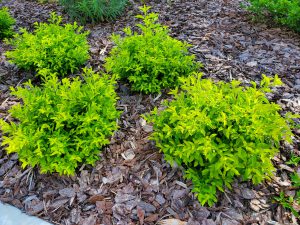
Incredible chartreuse foliage of ‘Gold Mound’.
Maybe my favorite part of ‘Gold Mound’ Duranta in the Panhandle is that it isn’t permanent. Duranta is a native of the Caribbean tropics and is not particularly cold hardy, most Northwest Florida winters knock it back hard, if not outright killing it. Therefore, ‘Gold Mound’ is best enjoyed here as an annual, planted when the weather warms in the spring, enjoyed until the first frost, then pulled up and discarded. Easy peasy. No long-term commitments required. My uncle, the chainsaw gardener, doesn’t even have to chop it back! Just compost the plants each winter or toss them in the trash, hit up your local nursery the next spring for some new plants and do it all over again. Though it has to be replanted each year, Duranta ‘Gold Mound’ won’t break the bank. The generic ‘Gold Mound’ is commonly sold in 4” containers for just a few dollars apiece in the annual section of plant nurseries, making it a very affordable option, especially compared to some of the new, designer perennials it competes with.
Though some landscape designers recommend just using a single specimen of ‘Gold Mound’ here and there for small pops of color, I prefer using groupings of the plant. I’ve seen successful plantings of ‘Gold Mound’ massed in large groups to create annual color beds at key points in landscapes and also planted across the front of a bed to complement darker foliaged backdrop or foundation plants, such as Boxwood or Loropetalum. Regardless of how you decide to use them in your yard, I don’t think you can go wrong with adding some color pizazz to your landscape with the inexpensive, low-maintenance, Florida-Friendly plant, ‘Gold Mound’ Duranta. Happy gardening!






















